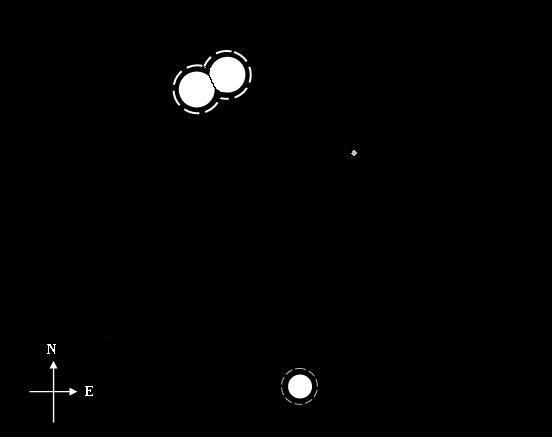
Alpha crucis viewed from my kitchen
Alpha crucis viewed from my kitchen
The conceptual drawing was created by microsoft word, recording what I saw last night through a five inch refracting telescope from my kitchen. I did not expect to see the 12.5 magnitude field star to the north east of alpha crucis under light polluted Singapore sky, however with little surprise I spotted it easily without using averted vision at 111X and a 7.4mm televue plossl. It seems that the limiting magnitude for a scope to find a pinpoint light source e.g. a dim star is less affected by light pollution.


- Canopus Lim
- Posts: 1144
- Joined: Fri Jun 03, 2005 12:46 pm
- Location: Macpherson
http://www.cruxis.com/scope/limitingmagnitude.htm
From the calculator it is possible to see Mag 12 stars in Singapore. Yes, observing stars is less affected by light pollution as one can always go to a higher magnification to 'avoid' the light pollution. That is the trick in urban observation. Using the highest magnification to frame the object, leading to a darker background. Stars being point sources will not get dim (though they get blurred due to the seeing) by going high magnification, while the background (scattered light) from the atmosphere will get darker since it is an extended object. I use at least 220x magnification when I observe DSOs in Singapore for that reason and sometimes I find that globular clusters can look rather fantastic despite the bad light pollution here in Singapore; but of course I prefer darker skies..better than nothing.
On the other hand extended object like galaxies and nebulae are hard to see in Singapore and it is quite independent on the size of the telescope because the contrast of the object is very low since the light pollution 'covers' it. There is no way to 'filter' out the object from the background as the Signal to Noise is already so low. Using bigger telescopes can help a bit only as it will have a larger exit pupil, enabling the eye to have a better sensitivity to low contrast details. Also, seeing them is more like detecting them only..
From the calculator it is possible to see Mag 12 stars in Singapore. Yes, observing stars is less affected by light pollution as one can always go to a higher magnification to 'avoid' the light pollution. That is the trick in urban observation. Using the highest magnification to frame the object, leading to a darker background. Stars being point sources will not get dim (though they get blurred due to the seeing) by going high magnification, while the background (scattered light) from the atmosphere will get darker since it is an extended object. I use at least 220x magnification when I observe DSOs in Singapore for that reason and sometimes I find that globular clusters can look rather fantastic despite the bad light pollution here in Singapore; but of course I prefer darker skies..better than nothing.
On the other hand extended object like galaxies and nebulae are hard to see in Singapore and it is quite independent on the size of the telescope because the contrast of the object is very low since the light pollution 'covers' it. There is no way to 'filter' out the object from the background as the Signal to Noise is already so low. Using bigger telescopes can help a bit only as it will have a larger exit pupil, enabling the eye to have a better sensitivity to low contrast details. Also, seeing them is more like detecting them only..
AstroDuck